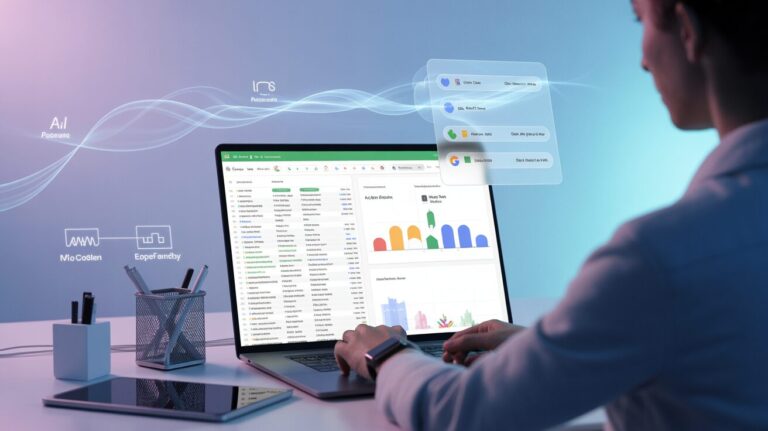Table Of Contents
- Understanding ROI for AI Workflow Automation
- Key Components of an Effective AI ROI Calculator
- Building Your AI Workflow Automation ROI Template
- Implementation Guide: Putting Your ROI Calculator to Work
- Common Challenges and How to Overcome Them
- ROI Calculation Examples Across Different Industries
- Creating Custom AI ROI Calculators with Estha
- Conclusion: Leveraging ROI Data to Drive AI Adoption
In today’s rapidly evolving business landscape, implementing AI workflow automation can deliver significant competitive advantages—but how do you quantify these benefits to justify the investment? Whether you’re a business leader considering AI implementation, a consultant advising clients on digital transformation, or an operations manager looking to streamline processes, having a robust ROI calculator for AI workflow automation is essential.
An effective ROI calculator transforms abstract promises of efficiency into concrete financial projections, helping stakeholders understand the tangible value of AI investments. This comprehensive guide will walk you through creating a customized ROI calculator template specifically designed for AI workflow automation projects, enabling you to make data-driven decisions with confidence.
From identifying the right metrics to track to implementing your calculator in real-world scenarios, we’ll cover everything you need to know about measuring the financial impact of your AI initiatives—no technical expertise required. Let’s explore how to build an ROI calculator that transforms AI workflow automation from a technological curiosity into a measurable business asset.
ROI Calculator for AI Workflow Automation
Quantifying the business value of AI investments
1Key Components of an AI ROI Calculator
Implementation Costs
- Technology subscriptions
- Integration expenses
- Training & change management
- Maintenance & updates
Time Savings
- Hours saved per task
- Task frequency
- Employee hourly cost
- Accelerated delivery schedules
Error Reduction
- Current error rate costs
- Direct costs (refunds, rework)
- Indirect costs (reputation)
- Projected AI error rates
2Building Your ROI Calculator Template
Define Time Horizon
Project ROI across multiple timeframes to capture increasing value as AI systems learn and improve.
Current Process Costs
Establish baseline costs including employee time, error rates, and throughput limitations.
Implementation Costs
Include platform subscription, integration, training, and additional resource requirements.
Projection Formulas
Calculate time savings, error reduction, throughput improvements, and new revenue opportunities.
Industry-Specific ROI Examples
Healthcare
AI automation typically reduces documentation time by 30%, increasing billable hours by 15-20%.
Financial Services
Banks see loan processing times reduced by 60% while decreasing costs by 40% and improving accuracy by 25%.
E-Commerce
AI customer service can handle 70% of inquiries without human intervention, providing 24/7 support.
3Common Challenges & Solutions
Quantifying Intangible Benefits
Use proxy metrics like reduced churn rate for customer satisfaction, and separate tangible ROI from unquantified benefits.
Accounting for Learning Curves
Build a realistic adoption curve with benefits gradually increasing over time rather than appearing immediately at full strength.
Ready to create your own AI ROI calculator?
Build custom AI applications in just 5-10 minutes with no coding required.
Understanding ROI for AI Workflow Automation
Return on Investment (ROI) for AI workflow automation differs significantly from traditional ROI calculations. While the fundamental formula remains the same—(Net Gain from Investment – Cost of Investment) / Cost of Investment—the variables involved require special consideration when applied to AI solutions.
AI workflow automation delivers value through multiple channels simultaneously: reducing labor costs, minimizing errors, accelerating processes, enabling 24/7 operations, and creating opportunities for innovation. This multifaceted impact makes ROI calculation both more complex and more crucial.
The timeline for AI ROI also follows a unique pattern. Initial implementation often requires investment in technology, training, and process redesign. However, unlike traditional technology investments where value depreciates over time, well-designed AI systems can actually increase in value as they learn from more data and as teams develop more sophisticated workflows around them.
When calculating ROI for AI workflow automation, it’s important to consider both quantitative metrics (time savings, error reduction, increased throughput) and qualitative benefits (improved employee satisfaction, enhanced customer experience, better decision-making). A comprehensive ROI calculator must account for both aspects to present an accurate picture of the investment’s value.
Key Components of an Effective AI ROI Calculator
A well-designed ROI calculator for AI workflow automation should include several essential components to ensure accurate and comprehensive analysis:
Implementation Costs
Your calculator should account for all upfront and ongoing expenses, including:
- Technology costs (software subscriptions, API access, computing resources)
- Integration expenses (connecting AI systems with existing infrastructure)
- Training and change management (preparing teams to work with new AI tools)
- Maintenance and updates (ensuring systems remain current and effective)
- Potential consultant or developer fees (if specialized expertise is required)
For no-code platforms like Estha, implementation costs are typically lower than traditional AI development, as they eliminate the need for specialized developers and reduce integration complexity. This cost advantage should be reflected in your ROI calculations.
Time Savings Metrics
Time is perhaps the most significant benefit of AI workflow automation. Your calculator should quantify:
The number of hours saved per task or process, multiplied by the frequency of that task, provides a baseline for time savings. This figure should then be translated into monetary terms by multiplying by the hourly cost of the employees who would otherwise perform these tasks.
Additionally, consider accelerated timelines. Many processes don’t just save time—they fundamentally change delivery schedules. For example, an AI-automated customer support system might reduce resolution times from days to minutes, creating significant downstream value that exceeds simple time savings.
Error Reduction and Quality Improvement
AI systems often excel at reducing errors and improving consistency. Your ROI calculator should quantify:
The cost of errors in your current processes (including direct costs like refunds or rework, and indirect costs like damaged customer relationships), multiplied by your error rate, gives you the total cost of errors. Compare this with the projected error rate after AI implementation to calculate savings.
Remember to consider not just the frequency of errors but their severity. Some errors might be rare but catastrophically expensive, making them prime candidates for AI-based prevention.
Scalability Benefits
Unlike human-driven processes that scale linearly with cost, AI solutions can often handle increased volume with minimal additional expense. Your calculator should model:
How costs will change as volume increases for both traditional and AI-driven approaches. This comparison often reveals that AI’s ROI improves dramatically at scale, making it particularly valuable for growing organizations or those with seasonal volume fluctuations.
The scalability advantage is especially pronounced with no-code platforms like Estha, where creating additional AI applications or scaling existing ones doesn’t require proportional increases in technical resources.
Revenue Enhancement Opportunities
Beyond cost savings, AI automation can create new revenue opportunities that should be factored into ROI calculations:
Increased throughput can allow businesses to serve more customers without adding staff. Improved customer experience may lead to higher retention rates and increased customer lifetime value. New AI-enabled products or services might open entirely new revenue streams.
These revenue enhancements often represent the most significant long-term value of AI workflow automation but can be the most challenging to predict accurately. Your calculator should allow for both conservative and optimistic projections of these benefits.
Building Your AI Workflow Automation ROI Template
Creating an effective ROI calculator template requires thoughtful organization and design. Here’s a step-by-step approach to building a template that’s both comprehensive and user-friendly:
Step 1: Define Your Time Horizon
AI investments typically show increasing returns over time, so your calculator should project ROI across multiple timeframes—typically quarterly for the first year and annually for 2-3 years beyond that. This approach captures both short-term benefits and the increasing value as systems learn and improve.
Step 2: Create Input Fields for Current Process Costs
Your calculator should begin by establishing a baseline of current costs, including:
Number of employees involved in the process, their average hourly wage, hours spent per week on tasks that could be automated, error rates and associated costs, current throughput limitations, and any other process-specific metrics relevant to your organization.
These inputs provide the foundation for comparing current processes with AI-automated alternatives.
Step 3: Add Implementation Cost Inputs
Include fields for all relevant implementation expenses:
Platform subscription costs (e.g., Estha’s pricing tier), integration expenses, training requirements, and any additional resources needed for implementation. For no-code platforms like Estha, these costs are typically lower than traditional development approaches, but they should still be comprehensively documented.
Step 4: Create Projection Formulas
Develop formulas that calculate:
Total implementation costs over time, projected time savings converted to monetary value, error reduction benefits, throughput improvements, and new revenue opportunities. These calculations should account for the gradual realization of benefits, with full impact often not achieved until several months after implementation.
Step 5: Design Visualization Components
ROI data is most impactful when visually represented. Include charts that show:
Cumulative costs vs. benefits over time, highlighting the breakeven point, monthly or quarterly net benefits, and ROI percentage over different time horizons. These visualizations make complex financial data accessible to stakeholders with varying levels of financial expertise.
Step 6: Add Scenario Comparison Functionality
Enable users to compare different implementation approaches by allowing multiple scenarios within the calculator. This functionality helps organizations identify the optimal scope and timing for their AI automation initiatives.
For example, users might compare a phased implementation approach against an enterprise-wide rollout, or evaluate different levels of investment in training and change management.
Implementation Guide: Putting Your ROI Calculator to Work
Creating an ROI calculator is only the first step—implementing it effectively requires a strategic approach:
Gather Accurate Baseline Data
The quality of your ROI projections depends entirely on the accuracy of your inputs. Before using your calculator in decision-making, invest time in collecting reliable data about your current processes.
This might involve time studies, error tracking, customer satisfaction analysis, or interviews with team members involved in the processes you’re considering for automation. The more precise this baseline data, the more reliable your ROI projections will be.
Involve Cross-Functional Stakeholders
Different departments will have unique perspectives on both the costs and benefits of AI workflow automation. Finance teams can validate cost assumptions, operations teams can provide insights on process mechanics, and customer-facing teams can identify quality improvement opportunities.
By involving representatives from all affected areas in the ROI calculation process, you’ll not only get more accurate projections but also build broader organizational support for the initiative.
Start with Pilot Projects for Validation
Rather than basing major investments solely on projected ROI, consider implementing a limited pilot project first. This approach allows you to validate your assumptions and refine your calculator based on actual results before scaling up.
Platforms like Estha are particularly well-suited for this approach, as they enable rapid development of AI applications that can be deployed in specific departments or processes before organization-wide implementation.
Establish Ongoing Measurement Systems
Your ROI calculator shouldn’t be used only for pre-implementation decision-making—it should evolve into a continuous monitoring tool that tracks actual returns against projections.
Set up systems to regularly collect data on the same metrics you used for baseline measurements, and update your calculator to compare projected benefits with actual results. This approach enables continuous improvement of both your AI implementations and your ROI modeling accuracy.
Common Challenges and How to Overcome Them
ROI calculation for AI workflow automation comes with several typical challenges:
Quantifying Intangible Benefits
Many AI benefits—such as improved customer satisfaction or employee experience—are difficult to assign direct monetary values to.
Solution: Use proxy metrics where possible. For example, customer satisfaction improvements can be linked to reduced churn, which has a calculable value. Where direct quantification isn’t possible, clearly separate tangible and intangible benefits in your reporting, using the quantifiable ROI as a minimum threshold while acknowledging additional unquantified value.
Accounting for Learning Curves
AI systems and the teams that use them typically don’t deliver maximum value immediately; there’s a learning period for both technology and users.
Solution: Build a realistic adoption curve into your calculator, with benefits gradually increasing over time rather than appearing immediately at full strength. No-code platforms like Estha can reduce this learning curve significantly, but some ramp-up period should still be factored into projections.
Balancing Precision with Usability
A highly detailed ROI calculator might be more accurate but can become too complex for practical use by non-specialists.
Solution: Create tiered calculator versions—a simplified version for initial assessments and stakeholder communications, and a more detailed version for final decision-making. This approach makes ROI accessible to all stakeholders while maintaining analytical rigor where needed.
ROI Calculation Examples Across Different Industries
The specific components and weights in an ROI calculator will vary by industry. Here are examples of how different sectors might approach AI workflow automation ROI:
Healthcare
In healthcare settings, AI workflow automation ROI calculations often emphasize:
Reduced administrative burden on clinical staff, allowing more time for patient care. Improved accuracy in processes like medication management or billing. Enhanced patient experience through more responsive service. Regulatory compliance improvements that reduce risk.
For a typical healthcare provider, AI automation might reduce documentation time by 30%, freeing up clinicians for additional patient interactions and potentially increasing billable hours by 15-20%.
Financial Services
Financial institutions typically focus their ROI calculations on:
Fraud detection improvements that reduce losses. Process acceleration for loan approvals or account openings. Compliance monitoring to prevent regulatory penalties. Enhanced customer self-service capabilities that reduce support costs.
A mid-sized bank implementing AI workflow automation might see loan processing times reduced by 60%, while simultaneously decreasing processing costs by 40% and improving accuracy by 25%.
Retail
Retailers often prioritize:
Inventory optimization to reduce carrying costs while preventing stockouts. Customer service automation that enables 24/7 support. Personalization capabilities that increase conversion rates. Supply chain efficiencies that reduce operational costs.
E-commerce businesses using AI automation for customer service can typically handle 70% of inquiries without human intervention, reducing support costs while extending service availability to 24 hours.
Education
Educational institutions focus on:
Administrative efficiency that redirects resources to instruction. Personalized learning experiences that improve student outcomes. Early intervention systems that identify at-risk students. Enrollment and admissions process optimization that improves yield rates.
Universities implementing AI workflow automation in admissions often see processing times decrease by 50% while improving applicant experience and conversion rates by 15-20%.
Creating Custom AI ROI Calculators with Estha
While spreadsheet-based ROI calculators are valuable tools, organizations can take their analysis to the next level by building interactive, customized calculators using no-code AI platforms like Estha.
Estha’s drag-drop-link interface makes it possible to create sophisticated ROI calculator applications without coding knowledge. Here’s how you can leverage Estha to build an advanced ROI calculator:
Interactive Data Collection
Rather than static input fields, an Estha-built ROI calculator can use conversational interfaces to gather information about current processes. This approach makes data collection more engaging and can improve the accuracy of inputs by providing contextual guidance throughout the process.
For example, instead of simply asking for “average processing time,” an AI-powered calculator could ask a series of questions about different steps in the process, then calculate the total automatically.
Industry-Specific Intelligence
Estha allows you to incorporate domain knowledge directly into your calculator. This means your ROI tool can provide industry-specific benchmarks and recommendations rather than generic calculations.
For instance, a healthcare-focused ROI calculator could incorporate typical time savings from automating specific clinical documentation processes, based on industry data and best practices.
Scenario Simulation
Advanced ROI calculators built with Estha can simulate different implementation scenarios and visualize the results dynamically. Users can adjust variables like implementation timelines, scope, or investment levels and immediately see the impact on projected returns.
This capability transforms ROI calculation from a one-time analysis into an interactive planning tool that supports strategic decision-making.
Integration with Business Systems
For organizations that want to continuously monitor actual ROI against projections, Estha applications can be connected to existing business systems to import real-time performance data.
This integration enables automatic updates to ROI projections based on actual results, creating a living document that becomes more accurate over time.
Building Your First ROI Calculator with Estha
Creating your own AI-powered ROI calculator with Estha is surprisingly straightforward:
- Define the inputs required for your specific use case
- Create a conversational flow to gather these inputs in a user-friendly way
- Build the calculation logic using Estha’s visual interface
- Design dynamic visualizations to display results
- Test with stakeholders and refine based on feedback
- Deploy as a standalone application or embed within existing systems
The entire process can be completed in just 5-10 minutes, with no coding required. Once built, your custom ROI calculator becomes a valuable asset for both internal decision-making and client consultations.
Conclusion: Leveraging ROI Data to Drive AI Adoption
An effective ROI calculator for AI workflow automation is more than just a financial tool—it’s a change management instrument that can transform how organizations perceive and implement AI technology.
By quantifying the concrete benefits of AI workflow automation, these calculators help bridge the gap between technical possibilities and business realities, making the value proposition clear to stakeholders at all levels. They transform AI from a mysterious “black box” technology into a measurable business asset with predictable returns.
As AI continues to evolve, ROI calculators must adapt as well. The most effective organizations are moving beyond static spreadsheets to dynamic, AI-powered calculation tools that can simulate complex scenarios and learn from actual implementation data. These advanced calculators don’t just measure value—they help create it by identifying the optimal implementation strategies for each unique organization.
Whether you’re just beginning your AI journey or looking to expand existing initiatives, a well-designed ROI calculator provides the clarity and confidence needed to make strategic investments in automation technology. By following the framework outlined in this guide and leveraging no-code platforms like Estha to create custom calculation tools, you can ensure your AI investments deliver maximum value with minimal risk.
Remember that ROI calculation is not a one-time exercise but an ongoing process of measurement, learning, and optimization. As your AI implementations mature, your understanding of their value will deepen, enabling increasingly sophisticated ROI projections that drive continued innovation and competitive advantage.
Ready to create your own custom AI ROI calculator? START BUILDING with Estha Beta today and transform how your organization measures and maximizes AI value—no coding required.



